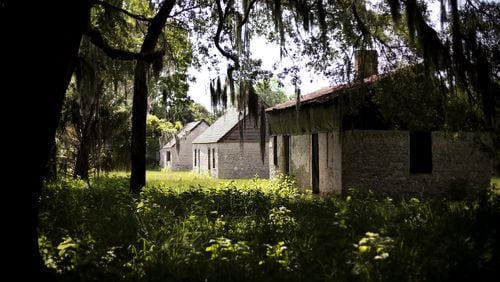Around the state it’s not hard to find Confederate monuments, statuary and portraits on government grounds.
Look a little harder, and you’ll find Georgia counties where Confederate flags, from the Bonnie Blue to the square battle emblem, fly on taxpayer property. But while the national debate continues over the appropriate placement of those memorials in a modern era, there is little argument that these emblems represent an indelible part of Civil War-era Southern history.
The same is also true for three small structures along a dirt lane on Ossabaw, Georgia’s third-largest barrier island. For if the Civil War was fought to maintain the economic power unpaid slave labor produced for the region, then it was waged over the very people who lived in these three cabins more than 160 years ago: enslaved African-Americans who grew Sea Island cotton for wealthy Georgia planters.
The names of the 18th and 19th century plantation owners endure: Morel, Kollock, Houston. The historical record of their lives runs deep.
For the slaves who worked the land, the written record is as thin as a ledger entry by J. W. Gillam, overseer for plantation owner George J. Kollock: “June 29, 1849: 17 head hoeing cotton/6 head ploughing/5 head gone to Rosegew for corn/2 head in the house.” Three days earlier Gillam “sent old Ranger to the doctor,” and put “Dolley to mind the children.”
The fate of those hands is lost to time. The tabbies they lived in on the south end of Ossabaw are long gone. But the three on the island’s north end remain as monuments to the slaves’ lives on the island and their stake in Southern heritage.
‘He bought families’
Only a handful of slave dwellings still stand in Georgia. The three tabby cabins at Ossabaw are among the most remote and rarely seen. Named for the mixture of burnt, crushed oyster shells, lime, sand and water that form their walls, each two-room cabin is about the size of a suburban, three-car garage. They are on 26,000 acres of land that became Georgia's first Heritage Preserve about a century after the Civil War's end.
After the war, the island changed ownership repeatedly until 1978 when the Torrey family, led by heiress Eleanor “Sandy” Torrey West, sold it to Georgia in a deal worth $16 million. Under the agreement, Ossabaw will never be developed.
By law, the “Heritage Preserve” designation ensures that Ossabaw is accessible only to researchers, scientists, artists, writers, for research and study and no more than 2,000 visitors a year.
For those who make it to the island and take rutted roads to its north end, the tabbies give clues to its history in the slave trade.
Georgia was supposed to be slave-free when the colony was established in 1733. But with South Carolina’s profits soaring from rice and indigo — a plant cultivated by enslaved Africans from seed to harvest to dye — chattel slavery became legal in Georgia 18 years later. Not long after, Ossabaw island owner John Morel bought slaves in Augusta to farm indigo at Ossabaw.
“Thirty people,” said Elizabeth DuBose, executive director of the Ossabaw Island Foundation. “He bought families. He didn’t just buy men.”
And based on archival records, he looked for people who’d come from African regions where the distinctive deep-blue indigo dyes had been made for centuries, DuBose said. Even now, 250 years after its introduction to the island, indigo sprouts randomly for acres near the tabbies.
Slaves remained the majority of people on Ossabaw until the Civil War, at one point numbering nearly 300. By then rice and Sea Island cotton had long since replaced indigo as the cash crops. Most slave owners lived in other parts of the state or the South and used the island as a profit center.
Though the homes of the earliest slaves are gone, the existing tabbies constructed between 1820 and 1850 are believed to be much like what stood before. They are what remain of at least 18 cabins on the North End.
‘The Camp’
For two months, half a dozen enslaved men and boys would gather oyster shells, burn them in a rudimentary kiln and convert them to lye, mix them with water and sand which were made into blocks. Step inside one of the cabins now and light peeps through the holes where wooden forms were used to lay each massive, chalky, white block.
One family lived in each side of a tabby, with a double-sided hearth dividing the rooms. Though the floors in two of the tabbies are now sandy earth, researchers believe the tabbies had wooden floors based on construction details uncovered in 2005.
The year before, the Ossabaw Island Foundation got a $400,000 federal “Saving America” grant to restore the cabins. Private donors, including actress Sandra Bullock, gave money toward the effort as well. Mark Frissell, operations manager on the Island, assisted with the painstaking excavation and restoration that is still ongoing.
Inside the southernmost tabby he pointed to hatch marks on a wall.
“Those are original brush marks from the slaves who added a lime wash to simulate paint,” Frissell said.
Glass panes, which would have been an original feature in 1840s, and open shutters fill the space with muted light. This is where the enslaved would make their own clothes from bolts of cloth given to them once a year. The back-acre where they grew food to supplement rations is visible through an open back door.
“You worked until your work was done and then you did your own personal chores,” said DuBose.
The island was essentially evacuated during the Civil War, the slaves sent to their owners’ other plantations. In 1865, Gen. William T. Sherman’s Special Field Order 15 seized all coastal land from Charleston, S.C., to the St. John’s River in Florida — including Georgia’s barrier islands — and guaranteed that former Sea Island slaves would each receive 40 acres of the property. But not one African-American slave descendant who returned to Ossabaw ever owned any part of the island. It remained a retreat for wealthy families until the sale in 1978.
The tabbies remained occupied for 125 years after the war by estate caretakers, drivers and cooks, many of them African-American. Each generation would add on a room, plumbing, electricity, all of which were removed when the restoration project began.
Emanuel “Hemo” Williams, 67, was raised on Ossabaw and lived in one of the tabbies until he was 5 years old. He now lives near Savannah. His parents worked for the Torrey family, his mother as a cook, his father as a foreman. In a photo album he has a picture of his parents holding him as a baby in front of a tabby. He has no idea whether he’s descended from anyone who was enslaved on the island.
“We used to call it ‘The Camp,’” Williams said. “My mama, she didn’t know the history of those tabbies. I didn’t know the history.”
He described how his mother would wake him early each morning and walk him to the dock to catch crabs with his father, and how his father would trap raccoons and mink, and hunt deer and squirrel for them to eat.
“Then we’d come back to the camp and Christmas and Dolly would keep me until mama and them come back from work,” said Williams, speaking of the two older black women who kept the island’s children as their parents worked.
Williams went on to have a career as a longshoreman on the mainland for 37 years. And yet, when he talked about the early years on Ossabaw, bits of his story felt like hearing lines from those long-ago Island ledgers.
About the Author







